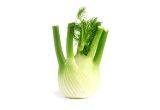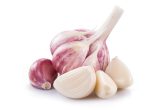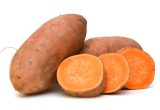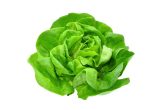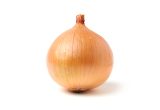Avocado

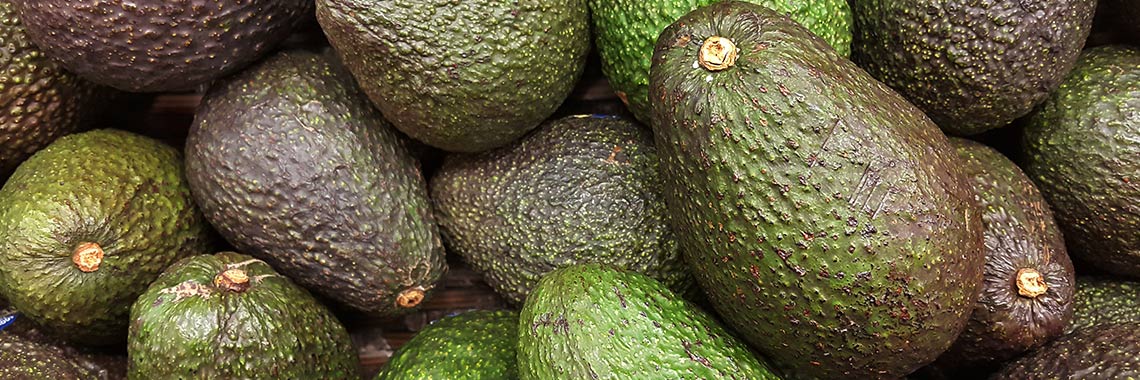
Description
- The avocado is the fruit of the avocado tree (Persea americana) which belongs to the Lauraceae family.
- It is a major agricultural fruit, originally grown in Mexico and Central America (Guzman-Rodriguez, 2013). It is usually consumed as a vegetable.
- There are several varieties of avocado, including Ettinger, Fuerte, Hass, Bacon and Pinkerton among others (CTIFL, INTERFEL, 2011).
PHYSICAL AND ORGANOLEPTIC CHARACTERISTICS
- The avocado is a medium-sized fruit with a pleasant creamy and smooth texture (Fulgoni, 2013).
- The colour of the skin may be bluish-purple or dark reddish due to the presence of anthocyanins, pigments with antioxidant activity (Corrales-García, 2019).
- A study on the profile of four avocado cultivars (Barker, Collinson, Fortuna and Geada) identified 84 volatile compounds:
- Hexanal, ethyl acetate, methyl dodecanoate, α-bergamotene and β-caryophyllene were present in all 4 cultivars.
- (E)-2-pentenal and ethyl acetate, responsible for the fruity aroma, were present in the Fortuna cultivar and the Collinson cultivar respectively.
- Benzaldehyde, responsible for the fruit and nutty aroma, was present at a higher concentration in the Geada cultivar and in trace amounts in the Barker cultivar (Galvao, 2016).
- Once the fruit falls from the avocado tree, the ripening process takes 5 to 7 days at room temperature. The fruit is considered ripe when it yields to light finger pressure (Di Stefano, 2017).
COMPOSITION CHARACTERISTICS (excluding macronutrients, vitamins and minerals).
- The avocado contains different polyphenols including perseitol, quinic, trans-cinnamic, pantothenic and abscisic acids, as well as catechin, whose concentrations decrease during the ripening process (Contreras-Gutierrez, 2013). Conversely, ferulic acid and ρ-coumaric acid concentrations increase (Contreras-Gutierrez, 2013).
- An Italian team evaluated the phenolic profiles of six avocado varieties grown in Sicily at different stages of ripening. Nineteen phenolic compounds were detected in extracts of avocado pulp. Gallic acid, sinapinic acid, vanillin, ρ-coumaric acid and gentisic acid were present only in ripe fruits. By contrast, epicatechin decreased with fruit ripening (Di Stefano, 2017).
- The antioxidants contained in this fruit give them a neuroprotective effect. In fact, they make it possible to limit the oxidative stress at the origin of significant neuronal damage found in amyotrophic lateral sclerosis, Huntington’s disease, Parkinson’s disease and Alzheimer’s (Ameer, 2016).
- The fruit may also improve high cholesterol and play an important role in cardiovascular health. The lipophilic fraction of the avocado inhibits the growth of prostate cancer cells, induces the death of breast cancer cells and suppresses liver damage (Di Stefano, 2017).
RAW
The following values are approximate and depend on variety, season, ripeness, cultivation conditions, etc. The avocado brings on average 205 calories (kcal) for 100 g, i.e. 843 kJ. One avocado weighs on average 200 g, which represents an energy intake of about 410 kcal.
COMPOSITION TABLES
For each nutrient, the tables provide information on the content, minimum and maximum values, as well as the percentage of the Dietary Reference Values (DRVs) per 100 g net of avocado.
MACRONUTRIENTS
| Constituent (g) | Average content |
Min-Max per 100g |
DRV% |
|---|---|---|---|
| Water | 70,30 | 63,20 - 83,80 | - |
| Fibers | 3,60 | 3,20 - 12,70 | - |
| Carbohydrates | 0,83 | NC - 6,50 | 0,32 |
| Sugars | 0,40 | 0 - 2,42 | 0,44 |
| Lipids | 20,60 | 8,40 - 23,20 | 29,43 |
| Saturated fat | 4,51 | 1,85 - NC | 22,55 |
| Protein | 1,56 | 0,30 - 3 | 3,12 |
| Constituent (g) | Amount | Min-Max | DRV% |
|---|---|---|---|
| Water | Ciqual 2020 (valeur issue des analyses Ciqual-Aprifel 2017) | - | - |
| Fibers | Ciqual 2020 (valeur issue des analyses Ciqual-Aprifel 2017) | - | - |
| Carbohydrates | Ciqual 2020 | - | Règlement (UE) N°1169/2011 du parlement Européen et du conseil du 25 octobre 2011 |
| Sugars | Ciqual 2020 (valeur issue des analyses Ciqual-Aprifel 2017) | - | Règlement (UE) N°1169/2011 du parlement Européen et du conseil du 25 octobre 2011 |
| Lipids | Ciqual 2020 (valeur issue des analyses Ciqual-Aprifel 2017) | - | Règlement (UE) N°1169/2011 du parlement Européen et du conseil du 25 octobre 2011 |
| Saturated fat | Ciqual 2020 (valeur issue des analyses Ciqual-Aprifel 2017) | - | Règlement (UE) N°1169/2011 du parlement Européen et du conseil du 25 octobre 2011 |
| Protein | Ciqual 2020 (valeur issue des analyses Ciqual-Aprifel 2017) | - | Règlement (UE) N°1169/2011 du parlement Européen et du conseil du 25 octobre 2011 |
Zoom on carbohydrates
- The amount of carbohydrates (0.83 g per 100 g) in the avocado is well below the average amount found in raw vegetables (4.45 g per 100 g).
- Avocados can be described as “sugar-free*” because they contain less than 0.5 g per 100 g, i.e. 0.4 g.
Zoom on fibres
- The fibre content of avocado is 3.60 g per 100 g, which is more than 3 g per 100 g, making it a source of fibre*.
- This amount is higher than the average amount found in raw vegetables (2.43 g per 100 g).
Zoom on lipids
- The fat content of avocados (20.60 g per 100 g) is much higher than the average content of raw vegetables (0.56 g per 100 g). It represents more than 91% of the energy of the avocado.
- These fats are divided into monounsaturated fatty acids (12.30 g per 100 g, including 8.72 g of oleic acid), saturated fatty acids (4.51 g per 100 g), and polyunsaturated fatty acids (2.83 g per 100 g, including 2.68 g of linoleic acid), with monounsaturated fatty acids predominating.
Zoom on protein
- The amount of proteins (1.56 g per 100 g) in the avocado is lower than the average amount found in raw vegetables (1.87 g per 100 g).
- The biological quality of avocado proteins is relatively good since they contain almost all the essential amino acids (except tryptophan) and in good proportions (Lerma-Garcia, 2007).
*Regulation (EC) No 1924/2006 of the European Parliament and of the Council of 20 December 2006 on nutrition and health claims made on foods.
MINERALS AND TRACE ELEMENTS
| Constituent | Average content |
Min-Max per 100g |
DRV% |
|---|---|---|---|
| Calcium (mg) | 9,40 | 5,71 - 19 | 1,18 |
| Chloride (mg) | < 20 | - | - |
| Copper (mg) | 0,18 | 0,09 - 0,38 | 18 |
| Iron (mg) | 0,34 | 0,14 - 1,06 | 2,43 |
| Iodine (µg) | < 20 | - | - |
| Magnesium (mg) | 21 | 17 - 34 | 5,60 |
| Manganese (mg) | 0,20 | 0,07 - NC | 10 |
| Phosphorus (mg) | 38 | 30 - 73,70 | 5,43 |
| Potassium (mg) | 430 | 219 - 691 | 21,50 |
| Selenium (µg) | < 20 | 0,80 - NC | - |
| Sodium (mg) | 6 | 1 - 17 | - |
| Zinc (mg) | 0,43 | 0,35 - 0,83 | 4,30 |
| Constituent | Amount | Min-Max | DRV% |
|---|---|---|---|
| Calcium (mg) | Ciqual 2020 (valeur issue des analyses Ciqual-Aprifel 2017) | - | Règlement (UE) N°1169/2011 du parlement Européen et du conseil du 25 octobre 2011 |
| Chloride (mg) | Ciqual 2020 (valeur issue des analyses Ciqual-Aprifel 2017) | - | Règlement (UE) N°1169/2011 du parlement Européen et du conseil du 25 octobre 2011 |
| Copper (mg) | Ciqual 2020 (valeur issue des analyses Ciqual-Aprifel 2017) | - | Règlement (UE) N°1169/2011 du parlement Européen et du conseil du 25 octobre 2011 |
| Iron (mg) | Ciqual 2020 (valeur issue des analyses Ciqual-Aprifel 2017) | - | Règlement (UE) N°1169/2011 du parlement Européen et du conseil du 25 octobre 2011 |
| Iodine (µg) | Ciqual 2020 (valeur issue des analyses Ciqual-Aprifel 2017) | - | Règlement (UE) N°1169/2011 du parlement Européen et du conseil du 25 octobre 2011 |
| Magnesium (mg) | Ciqual 2020 (valeur issue des analyses Ciqual-Aprifel 2017) | - | Règlement (UE) N°1169/2011 du parlement Européen et du conseil du 25 octobre 2011 |
| Manganese (mg) | Ciqual 2020 (valeur issue des analyses Ciqual-Aprifel 2017) | - | Règlement (UE) N°1169/2011 du parlement Européen et du conseil du 25 octobre 2011 |
| Phosphorus (mg) | Ciqual 2020 (valeur issue des analyses Ciqual-Aprifel 2017) | - | Règlement (UE) N°1169/2011 du parlement Européen et du conseil du 25 octobre 2011 |
| Potassium (mg) | Ciqual 2020 (valeur issue des analyses Ciqual-Aprifel 2017) | - | Règlement (UE) N°1169/2011 du parlement Européen et du conseil du 25 octobre 2011 |
| Selenium (µg) | Ciqual 2020 (valeur issue des analyses Ciqual-Aprifel 2017) | - | Règlement (UE) N°1169/2011 du parlement Européen et du conseil du 25 octobre 2011 |
| Sodium (mg) | Ciqual 2020 (valeur issue des analyses Ciqual-Aprifel 2017) | - | - |
| Zinc (mg) | Ciqual 2020 (valeur issue des analyses Ciqual-Aprifel 2017) | - | Règlement (UE) N°1169/2011 du parlement Européen et du conseil du 25 octobre 2011 |
Zoom on minerals and trace elements
- Avocados are a source of:
- potassium, as they provide the equivalent of 21.50% of DRVs for potassium, i.e. 430 mg per 100 g;
- copper, as they provide the equivalent of 18% of DRVs for copper, i.e. 0.18 mg per 100 g.
- They also provide a significant amount of manganese, representing the equivalent of 10% of DRVs for manganese (i.e. 0.20 mg per 100 g).
- The other minerals and trace elements are present in quantities representing less than 6% of DRVs.
VITAMINS
| Constituent | Average content |
Min-Max per 100g |
DRV% |
|---|---|---|---|
| Provitamin A Beta-carotene (µg) | < 5 | NC - 140 | - |
| Vitamin A equivalent (µg) | < 0,83 | NC - 23,303 | - |
| Vitamin B1 (mg) | 0,052 | 0,011 - 0,10 | 4,73 |
| Vitamin B2 (mg) | 0,037 | NC - 0,18 | 2,64 |
| Vitamin B3 (mg) | 1,56 | 0,36 - 2,51 | 9,75 |
| Vitamin B5 (mg) | 1,07 | 0,61 - 2,71 | 17,83 |
| Vitamin B6 (mg) | 0,17 | 0,07 - 0,45 | 12,14 |
| Vitamin B9 (µg) | 70,4 | 14 - 155 | 35,20 |
| Vitamin C (mg) | < 0,50 | NC - 24,10 | - |
| Vitamin E (mg) | 2,23 | 0,66 - 3,28 | 18,58 |
| Vitamin K1 (µg) | 14,50 | 8 - 27 | 19,33 |
| Constituent | Amount | Min-Max | DRV% |
|---|---|---|---|
| Provitamin A Beta-carotene (µg) | Ciqual 2020 (valeur issue des analyses Ciqual-Aprifel 2017) | - | - |
| Vitamin A equivalent (µg) | Calcul à partir de la valeur Provitamine A Béta-carotène* | - | Règlement (UE) N°1169/2011 du parlement Européen et du conseil du 25 octobre 2011 |
| Vitamin B1 (mg) | Ciqual 2020 (valeur issue des analyses Ciqual-Aprifel 2017) | - | Règlement (UE) N°1169/2011 du parlement Européen et du conseil du 25 octobre 2011 |
| Vitamin B2 (mg) | Ciqual 2020 (valeur issue des analyses Ciqual-Aprifel 2017) | - | Règlement (UE) N°1169/2011 du parlement Européen et du conseil du 25 octobre 2011 |
| Vitamin B3 (mg) | Ciqual 2020 (valeur issue des analyses Ciqual-Aprifel 2017) | - | Règlement (UE) N°1169/2011 du parlement Européen et du conseil du 25 octobre 2011 |
| Vitamin B5 (mg) | Ciqual 2020 (valeur issue des analyses Ciqual-Aprifel 2017) | - | Règlement (UE) N°1169/2011 du parlement Européen et du conseil du 25 octobre 2011 |
| Vitamin B6 (mg) | Ciqual 2020 (valeur issue des analyses Ciqual-Aprifel 2017) | - | Règlement (UE) N°1169/2011 du parlement Européen et du conseil du 25 octobre 2011 |
| Vitamin B9 (µg) | Ciqual 2020 (valeur issue des analyses Ciqual-Aprifel 2017) | - | Règlement (UE) N°1169/2011 du parlement Européen et du conseil du 25 octobre 2011 |
| Vitamin C (mg) | Ciqual 2020 (valeur issue des analyses Ciqual-Aprifel 2017) | - | Règlement (UE) N°1169/2011 du parlement Européen et du conseil du 25 octobre 2011 |
| Vitamin E (mg) | Ciqual 2020 (valeur issue des analyses Ciqual-Aprifel 2017) | - | Règlement (UE) N°1169/2011 du parlement Européen et du conseil du 25 octobre 2011 |
| Vitamin K1 (µg) | Ciqual 2020 (valeur issue des analyses Ciqual-Aprifel 2017) | - | Règlement (UE) N°1169/2011 du parlement Européen et du conseil du 25 octobre 2011 |
Zoom on vitamins
- The avocado is high in vitamin B9, as it brings the equivalent of 35.20 % of DRVs for vitamin B9, i.e. 70.40 µg for 100 g.
- It is also a source of:
- vitamin K1, as it provides the equivalent of 19.33 % of DRVs for vitamin K1, i.e. 14.50 µg per 100 g;
- vitamin E, as it provides the equivalent of 18.58 % of DRVs for vitamin E, i.e. 2.23 mg per 100 g;
- vitamin B5, as it provides the equivalent of 17.83% of DRVs for vitamin B5, i.e. 1.07 mg per 100 g. Moreover, according to the data of the Ciqual 2020 table, the avocado is the 2nd vegetable, after the mushroom, which contains the most vitamin B5.
- The content in vitamin B6 of the avocado is also notable since it is 0.17 mg for 100 g, which corresponds to 12.14 % of DRVs for vitamin B6.
- The other vitamins are present in quantities of less than 10% of DRVs.
*Calculation performed: Beta Carotene / 6 + retinol
POLYPHENOLS
| Constituent (mg) | Average content |
Min-Max per 100mg |
|---|---|---|
| Total polyphenols | 152,12 | 24,20 - 187 |
| Constituent (mg) | Amount | Min-Max |
|---|---|---|
| Total polyphenols | Phénol-Explorer version 3.6 Méthode utilisée : Folin assay | - |
Zoom on polyphenols
- Polyphenols are substances with an antioxidant effect.
- Avocados have a significant content of total polyphenols according to the Folin assay method.
Nutrition and health claims
According to the definitions of nutrition claims as set out in Regulation (EC) No 1924/2006 on nutrition and health claims, and in view of the composition of the avocado, the following claims may be used:
NUTRITION CLAIMS OF AVOCADO
- Sugar-free (100 g of avocado contain no more than 0.5 g of sugars)
- High in vitamin B9 (100 g of avocado provide the equivalent of more than 30% of DRVs).
- Source of fibre (100 g of avocado contain more than 3 g of fibre)
- Source of potassium (100 g of avocado provide the equivalent of more than 15% of DRVs)
- Source of vitamin K1 (100 g of avocado provide the equivalent of more than 15% of DRVs)
- Source of vitamin E (100 g of avocado provide the equivalent of more than 15% of DRVs)
- Source of copper (100 g of avocado provide the equivalent of more than 15% of DRVs)
- Source of vitamin B5 (100 g of avocado provide the equivalent of more than 15% of DRVs)
HEALTH CLAIMS (for a consumption of 100 g of avocado)
Folates or vitamin B9
- Folates contribute to:
- maternal tissue growth during pregnancy,
- normal amino acid synthesis,
- normal blood formation,
- normal homocysteine metabolism,
- normal psychological function,
- normal function of the immune system,
- reduction of tiredness and fatigue.
- Folates have a role in the process of cell division.
Potassium
- Potassium contributes to:
- normal functioning of the nervous system,
- normal muscle function,
- maintenance of normal blood pressure.
Vitamin K1
- Vitamin K1 contributes to:
- maintenance of normal bones,
- normal blood clotting.
Vitamin E
- Vitamin E contributes to the protection of cells from oxidative stress.
Copper
- Copper contributes to:
- maintenance of normal connective tissues,
- normal energy-yielding metabolism,
- normal functioning of the nervous system,
- normal hair pigmentation,
- normal iron transport in the body,
- normal skin pigmentation,
- normal function of the immune system,
- protection of cells from oxidative stress.
Vitamin B5 or pantothenic acid
- Pantothenic acid contributes to:
- normal energy-yielding metabolism,
- normal mental performance,
- normal synthesis and metabolism of steroid hormones, vitamin D and some neurotransmitters,
- reduction of tiredness and fatigue.
References
- Agence nationale de sécurité sanitaire de l’alimentation, de l’environnement et du travail. Table de composition nutritionnelle des aliments Ciqual 2020. Consultée le 27/07/2020 depuis le site internet Ciqual https://ciqual.anses.fr/
- Ameer K. Avocado as a Major Dietary Source of Antioxidants and Its Preventive Role in Neurodegenerative Diseases. Advances in Neurobiology. 2016;12:337–54.
-
Contreras-Gutiérrez PK, Hurtado-Fernández E, Gómez-Romero M, Ignacio Hormaza J, Carrasco-Pancorbo A, Fernández-Gutiérrez A. Determination of changes in the metabolic profile of avocado fruits (Persea americana) by two CE-MS approaches (targeted and non-targeted). Electrophoresis. 2013;34(19):2928-42.
- Corrales-García JE, Del Rosario García-Mateos M, Martínez-López E, Barrientos-Priego AF, Ybarra-Moncada MC, Ibarra-Estrada E, et al. Anthocyanin and Oil Contents, Fatty Acids Profiles and Antioxidant Activity of Mexican Landrace Avocado Fruits. Plant Foods for Human Nutrition (Dordrecht, Netherlands). 2019;74(2):210–5.
- CTIFL, INTERFEL, 2011. Guide des fruits et légumes en restauration hors-domicile.
- Di Stefano VD, Avellone G, Bongiorno D, Indelicato S, Massenti R, Bianco RL. Quantitative evaluation of the phenolic profile in fruits of six avocado (Persea americana) cultivars by ultra-high-performance liquid chromatography-heated electrospray-mass spectrometry.International Journal of Food Properties. 2017;20(6): 1302–12.
- Fulgoni VL 3rd, Dreher M, Davenport AJ. Avocado consumption is associated with better diet quality and nutrient intake, and lower metabolic syndrome risk in US adults: results from the National Health and Nutrition Examination Survey (NHANES) 2001-2008. Nutr J. 2013;12:1.
- Galvao M de S, Nunes ML, Constant PBL, Narain N, Galvao M de S, Nunes ML, et al. Identification of volatile compounds in cultivars barker, collinson, fortuna and geada of avocado (Persea americana, Mill.) fruit. Food Science and Technology. 2016;36(3): 439–47.
- Guzmán-Rodríguez JJ, López-Gómez R, Suárez-Rodríguez LM, Salgado-Garciglia R, Rodríguez-Zapata LC, Ochoa-Zarzosa A, López-Meza JE. Antibacterial activity of defensin PaDef from avocado fruit (Persea americana var. drymifolia) expressed in endothelial cells against Escherichia coli and Staphylococcus aureus. Biomed Res Int. 2013;2013:986273.
- Lerma-García MJ, Ramis-Ramos G, Herrero-Martínez JM, Simó-Alfonso EF. Classification of vegetable oils according to their botanical origin using amino acid profiles established by direct infusion mass spectrometry. Rapid Commun Mass Spectrom. 2007;21(22):3751-5.
- Neveu V, Perez-Jiménez J, Vos F, Crespy V, du Chaffaut L, Mennen L, Knox C, Eisner R, Cruz J, Wishart D, Scalbert A. (2010) Phenol-Explorer: an online comprehensive database on polyphenol contents in foods. Database, doi: 10.1093/database/bap024. Full text (free access)
- Règlement (CE) N° 1924/2006 du Parlement européen et du Conseil du 20 décembre 2006 concernant les allégations nutritionnelles et de santé portant sur les denrées alimentaires.
- Règlement (UE) N°432/2012 de la Commission du 16 mai 2012 établissant une liste des allégations de santé autorisées portant sur les denrées alimentaires, autres que celles faisant référence à la réduction du risque de maladie ainsi qu’au développement et à la santé infantiles.
- Règlement (UE) n°1169/2011 du Parlement européen et du Conseil du 25 octobre 2011 concernant l’information des consommateurs sur les denrées alimentaires, modifiant les règlements (CE) n°1924/2006 et (CE) n°1925/2006 du Parlement européen et de Conseil et abrogeant la directive 87/250/CEE de la Commission, la directive 90/496/CEE du Conseil, la directive 1999/10/CE de la Commission, la directive 200/13/CE du Parlement européen et du Conseil, les directives 2002/67/CE et 2008/5/CE de la Commission et le règlement (CE) n°608/2004 de la Commission.





